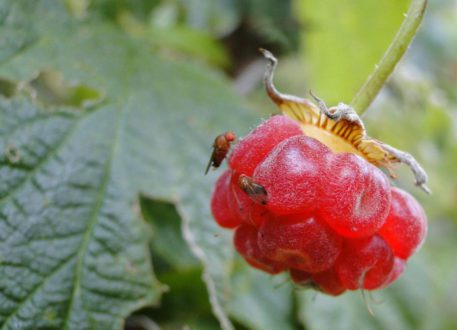Jun 21, 2017Designing effective baits for SWD is no easy task
Spotted wing drosophila (Drosophila suzukii), is an invasive fruit fly species from eastern Asia, first seen in the United States in 2008. The species is devastating to fruit crops, causing economic losses in the U.S. of hundreds of millions of dollars. Spotted wing drosophila feeds on a wide range of host plants, especially strawberries, blueberries, raspberries, blackberries, and cherries. It can disperse to new areas quickly. It has a high reproductive rate. And whereas almost all drosophila species can only deposit eggs in already damaged fruit, D. suzukii has serrations that allow it to pierce the skin of intact fruits to lay eggs. Once the eggs are deposited inside fruit, they decimate fruit and can eliminate entire crops.
Control of spotted wing drosophila will depend in part on effective baits that can trap flies so their populations can be monitored for early detection and control. A recent study from Michigan State University by Juan Huang, Ph.D., and colleagues, published this month in Environmental Entomology, made discoveries that will inform design of more effective baits for this invasive species.
Early detection is especially important with spotted wing drosophila because, to be effective, control should begin when the flies first arrive in a farm or orchard; once they lay eggs in the fruits, outbreaks are extremely difficult to control. Baits for detection consist of a chemical solution that attracts and traps the flies and an enclosing structure that holds the attractant solution. The search for a highly effective attractant for spotted wing drosophila is complicated by one of the factors that make this species so destructive to crops: It uses a variety of food types, and so there is not one type of attractant that it focuses on exclusively. Matthew Grieshop, Ph.D., the principal investigator of the study, says, “The big challenge with Drosophila suzukii is that they are generalists. Understanding the chemical cues they respond to is very difficult because they are attracted to so many different fruits.”
Apple cider vinegar is often used as an attractant for spotted wing drosophila. In a study published in 2012, Dong Cha, Ph.D., and colleagues found that a mixture of red wine and vinegar was more attractive than vinegar or wine alone, and, in a study published in 2013, Cha and colleagues found that a synthetic lure containing volatile chemicals present in red wine and rice vinegar was as attractive as a wine-vinegar solution. In 2015, Hannah Burrack, Ph.D., and colleagues found that a mixture of yeast, apple cider vinegar, whole wheat flour, and sugar was even more attractive than the synthetic lure. And Cha and colleagues refined the formulation further in a study published earlier this year.
It makes sense that fruit flies are attracted to yeast: yeast is often present in rotting fruits, and yeast is a food of fruit flies in nature. In their new study, Huang and her colleagues built on this previous work, investigating the effect of different proportions of vinegar on attractiveness and testing whether yeast combined with a wine-vinegar solution was effective as an attractant.
Lab experiments
To examine the effect of different proportions of vinegar in an attractant, Huang and colleagues presented spotted wing drosophila flies in the lab with combinations of red wine and rice vinegar. They tested six wine-to-vinegar ratios: 100:0, 80:20, 60:40, 40:60, 20:80, and 0:100. They found that more flies were captured in the 0 percent vinegar and 20 percent vinegar solutions than in solutions with 40 percent or more vinegar, and the fewest flies were caught in the 100 percent vinegar solution. The authors suggest that the vinegar makes the solution less attractive because it raises the acidity. Previous studies have observed decreased attractiveness with increased acidity, and the authors suggest that baits will be more effective if the level of acetic acid, a primary component of vinegar, is kept under 2 percent.
In another lab experiment, flies were presented with five different solutions: 80 percent Merlot wine and 20 percent rice vinegar; yeast; the top layer from a fermenting mix of yeast and sugar (yeast supernatant); a combination of wine and yeast; and a combination of wine and yeast supernatant. They found that the wine-yeast and the wine-yeast supernatant solutions were preferred over the wine, vinegar, or yeast solutions. Therefore, they found confirmation of a main hypothesis of their study, that a wine plus yeast solution would form an effective attractant.
That flies choose wine with yeast supernatant as much as wine with regular yeast offers a practical advantage—yeast supernatant is less prone to spoiling. Also, wine itself has a big benefit beyond being attractive to flies: It preserves the specimens that become trapped in the bait, easing species identification.
Field experiment
In a cherry orchard in Michigan, Huang and colleagues presented flies with the same five solutions tested in the lab. They found that significantly more male spotted wing drosophila were caught in the wine or yeast solutions than in other solutions, and they found that significantly more females were caught in the wine solution than in other solutions.
The study’s results from the field were much less clear cut than the results in the lab—but that makes sense. Grieshop commented that the chemical landscape in the wild is tremendously more complex. A range of different fruits and a huge array of chemicals are present in the wild that are not present in the lab. “This makes attracting flies in the field much more complicated,” Grieshop says. “To make lab experiments more realistic, we need to come up with background volatility blends that are representative of the wild.”
– John P. Roche
Photo above: In a study of bait formulations to attract Drosophila suzukii, also known as spotted wing drosophila, researchers at Michigan State University found that combinations of wine and yeast are more attractive than either ingredient alone. (Photo credit: Hannah Burrack, North Carolina State University, Bugwood.org)
Source: Entomology Today















